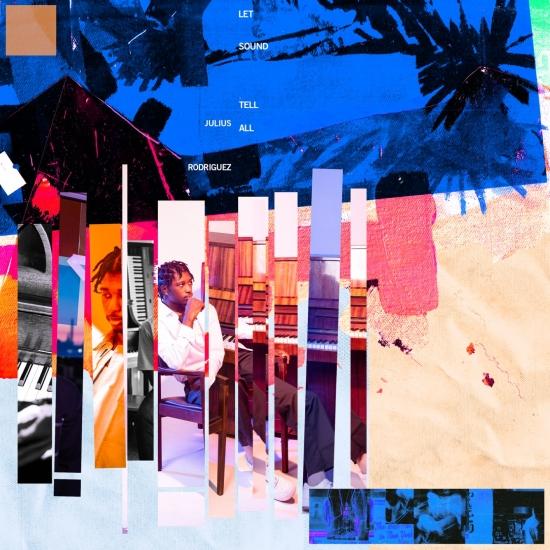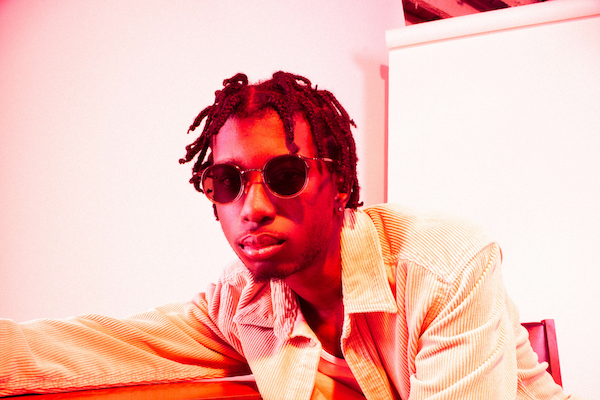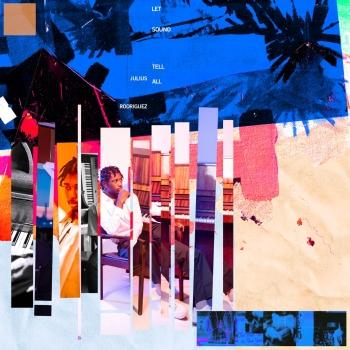
Let Sound Tell All Julius Rodriguez
Album info
Album-Release:
2022
HRA-Release:
10.06.2022
Album including Album cover
I`m sorry!
Dear HIGHRESAUDIO Visitor,
due to territorial constraints and also different releases dates in each country you currently can`t purchase this album. We are updating our release dates twice a week. So, please feel free to check from time-to-time, if the album is available for your country.
We suggest, that you bookmark the album and use our Short List function.
Thank you for your understanding and patience.
Yours sincerely, HIGHRESAUDIO
- 1Blues At The Barn03:34
- 2All I Do04:40
- 3Interlude01:08
- 4Gift Of The Moon02:58
- 5Two Way Street04:02
- 6Where Grace Abounds04:21
- 7Elegy (For Cam)07:50
- 8In Heaven05:03
- 9Philip’s Thump01:04
Info for Let Sound Tell All
Is it fair to call Julius Rodriguez and the community of young artists he works with jazz’s new vanguard? The 23 year-old musician does not bristle at that four-letter word the way many of his colleagues who practice great Black American Music do. Having studied jazz since childhood, attending its prominent youth programs and learning institutions while developing a playing dexterity and a composer’s ear for its blues-, spirituals-, and ballad-related cornerstones, Julius recognizes jazz’s cultural value and the processes that further its prestige as America’s classical music. But what becomes abundantly apparent from listening to Let Sound Tell All, Rodriguez’s debut album, is that, schooled though he may be in jazz’s conventions, Julius doesn’t believe in the limitations by which jazz’s guardians have come to define it.
When you hear Julius Rodriguez play “the music,” as he calls it, it’s a modern Sound, as fluent in history as it is aware of its contemporary context. His music dares to imagine a future of new standards and sonic excitement. This vanguard was raised in an atmosphere where pop and hip-hop and dance influenced their approaches to melody and harmony and rhythm, so of course it is part of their improvisational DNA. And that’s what Julius Rodriguez’s Sound tells to whoever will choose to listen.
On some level, this open-mindedness has been a part of Julius Rodriguez’s approach for much of his young life. Even creative eclecticism must have its seeds, and Julius’ were planted via interest from Audrey McCallum, a historic figure at Baltimore’s Peabody Conservatory (she was the first African-American student at its preparatory high school in the ’50s) and a beloved music teacher at Charm City’s public schools. McCallum was also friends with the Rodriguez family, and it was upon her recommendation that young Julius began taking classical piano lessons at age three, developing a strong music-theory foundation. This instruction was put to action at the Greenburgh, NY church that the Rodriguez family attended, which was where Julius would play all manner of keyboards (including the organ) and drums from a young age.
As Julius was revealing a deep musical aptitude, his father, Adlher, a jazz fan attuned to legends like Coltrane and Monk and contemporaries like Earl Klugh and Stanley Jordan, became deeply involved in his son’s musical education– going so far as shepherding his then-11 year-old son to a 1am jam session at Greenwich Village’s famed Smalls club, upon discovering that Jeremy Manasia, Julius’ soon-to-be piano instructor at Manhattan School of Music’s youth program, would be performing there. (Julius says he wore a gray hoodie and played Duke Ellington’s “Take the A Train,” and adds “that was my song!”). It was also the beginning of the younger Rodriguez’s love for jazz clubs, which he’s been haunting regularly ever since.
High school at the progressive Masters School in Dobbs Ferry was augmented with time spent at such lauded music programs as MSM’s and Berklee’s, and that of the YoungArts Foundation, while also playing youth recitals and gigs. It’s in this milieux that Julius first found himself around inspirational young musicians, like bassist Darryl Johns (who appears on Let Sound Tell All), and saxophonist Isaiah Barr (whose group Onyx Collective has been instrumental in Rodriguez’s evolving musical mindset). He wound up at Juilliard with other members of the generational vanguard — Julius’ roommates in his first Manhattan apartment were his current bass player Philip Norris, pianist Isaiah Thompson and saxophonist Immanuel Wilkins — but left the school’s strictly tradition-minded program in 2018.
Thinking about his music’s progress in retrospect, Rodriguez remembers “a perfect backhanded compliment” from drummer Terri Lynne Carrington during a five-week stint at Berklee’s summer program, that proved crucial: “She said, ‘When we played that last tune, for a minute there, it sounded like Art Blakey came down from heaven.’ But then she added, ‘That’s not all there is — you can’t get tied up in the tradition.’ It made me consider what I was focusing on, and what I was maybe leaving out. That’s the moment I think about to this day: you can’t get tied up in tradition, you gotta expand.”
In some ways, this expansion was as ever-present as his orthodox music education. Alongside jazz, Stevie Wonder and the Beatles were omnipresent on the Rodriguez family stereo; and as Julius omnivored the Internet for musical discoveries, he heard jazz pianists like Jacky Terrason and The Bad Plus’ Ethan Iverson spin their own version of contemporary repertoire, pop and otherwise. When Julius was in his early teens he went to New York’s Governors Ball festival with friends, an event that he says “kind of changed my life. I was used to jazz concerts, things that don’t normally happen on a large scale. So to see musicians playing in front of so many people who were excited to be there, that flipped the switch like, ‘Maybe I should look into these other kinds of music.” He started listening to James Blake, Sampha and Solange; and at the Masters School, began participating in an annual concert students would produce by recreating a classic album, learning everything about Michael Jackson’s Thriller and U2’s Joshua Tree. His jazz professors also encouraged him to stretch out, as when Manasia introduced him to Shuggie Otis.
Rodriguez was always playing with singer-songwriters and other musicians outside his youth jazz circles. When he got to Juilliard, he began playing with music students from other New York universities; and with his old friend Isaiah Barr’s Onyx Collective, whose Lower East Side reputation as a young group equally comfortable with indie-rock and hip-hop, with standards and rare grooves, made fans of downtown jazzers like Roy Nathanson and Marc Ribot, but also A$AP Rocky. (The platinum rapper hired them as his band on a 2018 tour, which made Rodriguez take a semester off of Juilliard and precipitated his leaving school). By early 2019, the breadth and nous of Julius’ work pointed towards eclecticism: he played organ for Me’shell Ndegeocello and the hip-hop production duo Brasstracks; piano on Carmen Lundy’s Grammy-nominated vocals album, Modern Ancestors; contributed to recordings by other vanguard non-traditionalists such as Morgan Guerin and Kassa Overall; and led his own jazz group in clubs around town. Additionally, his working musician acumen was getting sharper. Even within the jazz community, he’d recognize how clubs and their patrons differentiated the music: “I observed how to play these spaces. You don’t go to all these places for the same kind of thing. I would play into that, see what I liked and didn’t like about it. Then my writing and music evolved and developed as I played in different spaces with different musicians.”
The more Rodriguez saw admired colleagues like Ndgeocello, Jon Batiste, saxophonist Braxton Cook, and singer-songwriter Gabriel Garzón-Montano embrace a variety of musical spaces, the more Carrington’s call for expansiveness made sense for the music he wanted to make. The earliest band recordings on Let Sound Tell All date back to 2017 — and all of them were completed by February 2019. At the time, Rodriguez says, the idea was to “document the group, the experimentation and the aspirations we were coming up with at the live shows, because there was a certain energy.” But in the ensuing year, as Julius’ excitement of capturing the group’s sound in a studio evolved into a desire to create an interesting record — made practical once the pandemic arrived in 2020 and the idea of gathering in a recording studio was no longer feasible — those original tapes became framework for a different kind of study. One that took on the many different musical lessons and directions that had excited Julius much of his life. With the help of producer/engineer Drew ofthe Drew, who would add a studio-based post-producer/sonic alchemist’s ear, a wonderful set of songs began to take shape. At times, Let Sound Tell All harkens to the small-group classic jazz that was locus to much of Julius’ upbringing; at others, it sounds contemporary and sleek as all get-out.
The opening “Blues at the Barn,” originally released as a single in 2020, was a perfect encapsulation of how both ideas could live together. An upbeat piano-trio traditional that has been a group live favorite, it opens the album with crowd applause that sounds like it was very specifically lifted from an older live jazz recording in front of a sizable audience; upright bassist Norris tugs at the strings in a “let’s start now” fashion, Rodriguez bangs out the theme, and drummer Joe Saylor joins in. On the recording, the whole band passes through one of Drew’s filters, and comes out the other side crisp and swinging. The song’s traditionalism is given spotlight by the production process, but also gets modernized before the listener’s very ears.
The bones of “Gift of the Moon” were among the album’s earliest tapes; Rodriguez calls it “the first song I wrote that wasn’t a traditional jazz song, since there’s no solo section.” He struggled for years trying to figure out what to do with it, until in 2019 he asked trumpeter Giveton Gelin to solo over the existing recording. Rodriguez couldn’t pick any of Gelin’s three takes, “so I used all of them at the same time, and it turned into what it is now,” a trick he picked up from George Martin and his youthful idolization of The Beatles’ studio hacks – as well as from Roy Hargrove’s recordings where the late trumpeter would play with himself. The addition of Julius’ synth parts and a wordless vocal from Onyx compadre Nick Hakim created a stunning instrumental miniature.
Ideas for some of Sound’s songs, on the other hand, were years in the making. Or at least its collaborative relationships were. Mariah Cameron, who sings the cover of Stevie Wonder’s “All I Do,” is an “old friend from back home in White Plains.” The song’s arrangement is not a flip of the take Stevie did on 1980’s Hotter Than July, but its original Motown version recorded by Tammi Terrell in 1966. No wonder then that for bass Julius brought on Ben Wolfe, one of his Juilliard professors who once played with Wynton Marsalis and the Harry Connick Jr. Orchestra (“When Harry Met Sally [soundtrack] is a desert island disc for me,” he says). The song’s old-school swinging backbeat is all the better for it.
And the downtempo “Where Grace Abounds,” allows Rodriguez to engage his profound spiritual side, a kind of duet between Rodriguez on electric piano and Hammond B-3 organ – before Gelin’s trumpet and Hakim’s voice arrive as late-in-the-song punctuations. For Julius, it is one of the album’s most self-reflective compositions, “a song I wrote at a time where I felt like I wasn’t being the best version of myself yet, and still a lot of great things were happening to me. So it’s me being grateful for being in the situation I’m in, even though I felt like I didn’t deserve it.” Drew ofthe Drew and Jon Castelli mix it into a ghostly, gospel-like wonder.
Taken together, Let Sound Tell All is a singular expression of the in-betweens that materialize in today’s musical spaces. For Julius and the vanguard, it’s less a digital dissolution of genres we often read about, than a thoughtful realignment of tradition by a generation who hears disparate things fitting together in a way their elders can not. They aren’t sure what to call it, or where it fits, but they know it’s important for the world to hear it and to have it.
“My music is improvisation based…but it’s influenced by a lot of other things too,” Julius says when asked that, if not jazz, what should we call his sound. “At one point I was calling it ‘jazz pop songs’ – it’s simpler melodies, shorter songs, shorter arrangements, but we were still soloing and playing jazz language over it. It’s just music that I write, influenced by all the things going on around me. Contemporary instrumental music. But it’s funny when you say something like that, people assume you’re gonna play some weird out/neoclassical [stuff]. No, you can improvise some simple things that people can sing back and dance through too. That’s what I wanna do. I feel like that’s one of the reasons why we don’t have a lot of instrumentalists in pop culture and at the forefront, because people just aren’t doing it.”
Julius Rodriguez, piano, drums, Hammond Organ, Moog Bass
Mariah Cameron, vocals
Hailey Knox, vocals
Samara Joy, vocals
Morgan Guerin, saxophone, bass
Philip Norris, double bass
Ben Wolfe, double bass
Daryl Johns, bass
Joe Saylor, drums
Brian Richburg, Jr, drums
Jongkook Kim, drums
Giveton Gelin, drums, trumpet
Vuyo Sotashe, backing vocals
Nick Hakim, backing vocals

Julius Rodriguez
Multi-instrumentalist and composer Julius Rodriguez has crafted his artistry inside a range of sounds and styles. At 23, the Westchester native bonds a deep sense of history with an appetite for the unknown. He performs regularly as a leader across New York City, and his contributions on piano, drums, synthesizer and electric bass appear on a diverse roster of recordings, including releases from Kassa Overall, Carmen Lundy, Brasstracks, Morgan Guerin, J. D. Walter and Damien Sneed, among other critically acclaimed genre-defiant voices.
Sharp instincts for space and phrasing, and reverence for melody elevate Julius’ expression from virtuoso to true artist. In a few short years, he has garnered peer attention and critical praise from such institutional outlets as JAZZIZ magazine, The New York Times, Paste and Vanity Fair, and has earned opportunities to perform alongside some of the music’s most distinctive artists, including Wynton Marsalis, Keyon Harrold, Victoria Canal, Ben Williams, A$AP Rocky, Meshell Ndegeocello, Macy Gray, Braxton Cook, Laurin Talese and the late and legendary Roy Hargrove.
This album contains no booklet.













